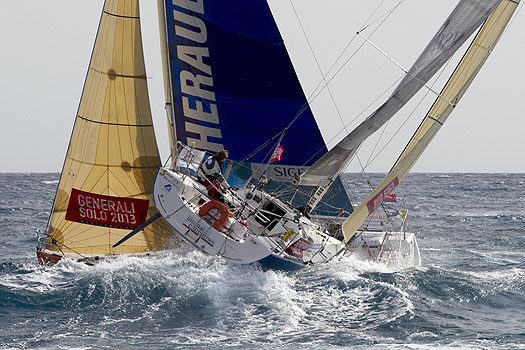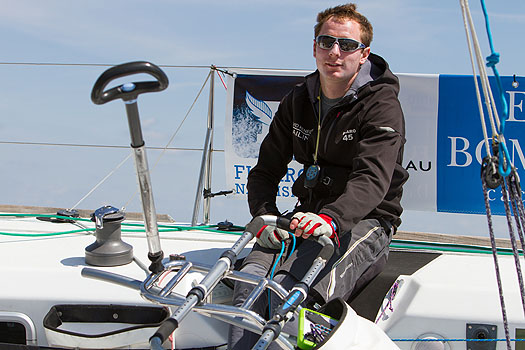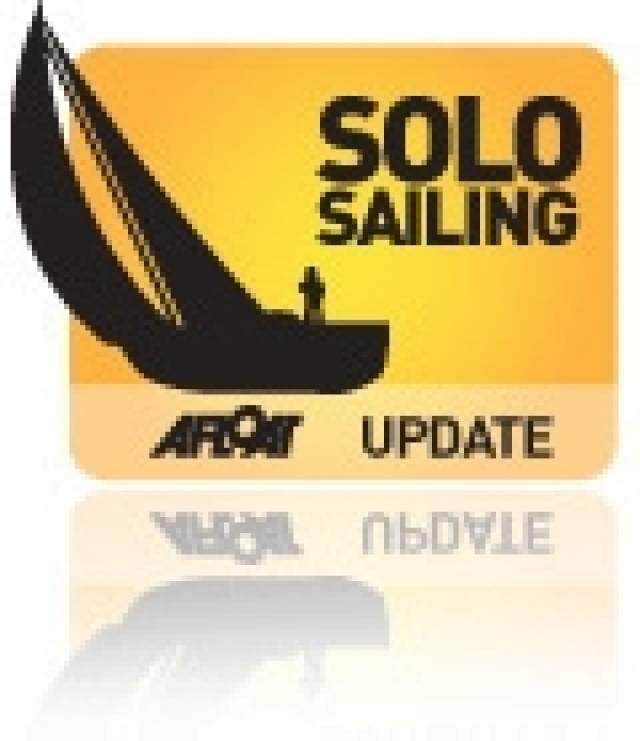#fullrish – This time last year I got my hands on the boat I was going to use for the next 12 months. I had wanted to try singlehanded offshore sailing since I could remember and at the ripe old age of 21 all my stars aligned and with help from many sources here I was. Port La Foret, the home of the Figaro class and most of the French offshore champions surrounded me. My boat was freshly launched with a bit of Irish identity plastered on to it. I knew I knew nothing at all but with my team manager Marcus Hutchinson, himself a four year veteran of the discipline, I took my first steps out into the bay with the boat and learnt the basics of how to hoist and drop a big mainsail on your own, who to hoist and retrieve the spinnaker on your own, how to gybe, tack, anticipate the actions required and basically how to make sure things are done in the right order so as to not exhaust myself. Very early on in the piece Marcus explained to me that short handed sailing was just one big exercise in energy management, whether it was ashore with boat preparation and looking after the body, or afloat in competition, knowing when to be a coiled spring and when to move at a slightly more reserved pace.
Twelve months later and where has the time gone. Since those initial ten days with Marcus I took the boat on a truck to the South of France and spent five months training, refining and learning whilst racing other Figaros in La Grande Motte. I met other sailors both French and non-French. The Artemis Offshore Academy boys were down there two. We have become great friends.
My first big event was in March this year. I learnt some difficult lessons. In the first offshore on a cold and windy leg I destroyed my mainsail, through no fault of my own. But the lesson was that it was my fault because there is no one to blame but the man in charge and that is me. During one of the inshore races I jagged the right side of the beat and rounded the top mark first. I thought I had won the world cup, but of course more experienced sailors got past me before the finish. I did it again in the last offshore leg of that event only to suffer terribly from tiredness and poor decision making to finish where I belonged, down the pan. But if I had won out of the bag I would never have learnt.
We moved the whole show to the Atlantic in April and two events followed, the Solo Arrimer and the Solo Concarneau in May. Lots of boats, suddenly the fleet was complete with all the really good guys. The first event was a 300-mile race up and down the French West coast. It started out really light in a huge sea. I started well and tacked to the right of the course with my all time hero – Michel Desjoyeaux. The short term made us look like the champion that he already was, but then the wind shifted back and we were both nearly a mile behind at the first windward mark. I then had to sail around the course in cold, wet, dark and at times up to 40 knot winds, to complete the course. A hard lesson to learn. Don't follow your hero, because there are champions everywhere on this course and I am not one of them. Mich of course pulled back all the way to the top ten, I limped home with just a couple of boats behind me, exhausted, dismayed and not really understanding what had happened! But that is where my coaching crew were there for. Until you do it you don't know. My coaches Nico Berenger and Marcus sat me and the other Artemis Offshore Academy lads down and we went through the race step by step. What were the key moments, what had the leaders done, why had they done it, what was the timing, when had they rested, how much had they eaten, how had it looked. There were always so many things to learn it was always overwhelming and it would have been easy to get disheartened but we just concentrated on what each race's three most important lessons were, across the whole group, and then applied them to our own preparation for the next race.
The pace kept getting quicker. Logistically it got harder and more demanding as we worked our way towards the start of the main race of the year the 2013 Solitaire du Figaro. We did as much as we could in the time available, always conscious that it would be easy to burn out early in the season and not get the most out of the opportunity in the big race.
The start of the Solitaire du Figaro was in Bordeaux, 70 miles up a very tidal river estuary. Logistically extremely complicated. Our little team of boats now numbered six and we pooled resources for shore side functions such as accommodation, shore crew and sail purchasing. We couldn't have done it any other way. The economies of scale made it financially possible to compete. But I hadn't appreciated the slog of the race week build-up. Right Downtown in a big city, huge amounts of media and public engagements for all skippers, weather and navigation to prepare and then all the boat and food considerations too. Again our shore team just removed everything from us allowing us to all concentrate on what would make our lives easiest, allowing us to have big siestas in the lead up so that our bodies were already into a disrupted sleep pattern before we started.
Just before the start sponsorship was secured which was a great help but came with the added complication of fulfillment. The most significant of these sponsors was the Comptoir Irlandais, a network of 50 shops scattered across France that sell Irish products only - from whiskeys to Barry's Tea, to woolens, to Tayto Crisps, to smoked salmon.... In a small way, the name of my boat Full Irish, had attracted them to me and I was now helping Irish exports to France by driving publicity to the shops and their products through the branding on my boat in this highly mediatized racing environment.
The start of the big race brought a huge number of guests, family and media, they all wanted a piece of me, they were all there for me. I hadn't appreciated how much it would take out of me. I was nervous for the start as the build up was huge and all I wanted to do was get going to the biggest sailing challenge of my life.
I started in the huge pack, tactically it was really complicated getting out of the river. Hundreds of spectator boats, helicopters, strong tide, a beat, shallow water, a big tactical decision early in the race... But in the back of my head I remembered my coaches' words. Just get out of the river, don't take risks, take your time and enjoy the experience, there would be 400 more miles to do things and have opportunities later on. What great advice that was. There were many other Rookies in the race. The favourite by far Simon Troel, went aground on a sandbank a couple of hours into the race and had to wait a full eleven hours before he could get off. Game over for him. I got out of the river unscathed apart from a little bump with something that wasn't on any chart!
The rest of the race to Porto, to Gijon, to Roscoff and to Dieppe, a total of 2000 miles of sleep deprevation, knocks, confusion, strong winds, light winds, fog, rain, rocks, tides, dramas and elation, I have written about already. I arrived in Dieppe at the end of June 3rd Rookie and 28th overall. I had completed the course, the youngest to do it that year – I had in fact turned 22 somewhere half way across the Bay of Biscay to shrieks of Happy Birthday to you/Bonne Aniversaire on the official race VHF Channel. Although on your own you are never alone. With 36 boats in the fleet for the most part you are always in site of at least a quarter of the fleet visually, half the fleet on AIS and just about everyone by VHF.

David Kenefick ducks a competitor in the Generali Solo. Photo: Alexis Courcoux
When I got to Dieppe I was destroyed. I had been warned about this period. I had become the fourth Irishman to complete the course over the race's 44-year history and was in a drunken haze and daze of extreme fatigue. I needed a break. I needed to reflect. I got the boat to Cowes, out of the water onto its cradle and went home to gather my thoughts. But this was the best time. Day by day I started to recover and realized I had achieved something. Worse was to come, as the days went by I realized this was the most amazing thing ever in the sailing world and the euphoria just wouldn't go away.
In the end we devised the second half of the season quickly. It was early July there were three big events left in the calendar, two of them two-handed (Fastnet and Tour of Brittany) and the last the Generali-Med which as the name suggests is in the Med.
When I was ready we started getting organized for the Fastnet Race which I sailed with Kinsale Dragon sailor Olaf Sorrensen. Then I did the Tour de Bretagne with Jeanne Gregoire, a very experienced Figaro racer, she had had more than her share of podium results over the previous few years. The goal was to really learn the Brittany coast and learn some tricks from an experienced sailor in a racing environment. Her part of the deal was to learn some English, but in reality it was another way for me to learn a bit more French.
In the background Marcus conjured up a deal for me to offset some of my costs for competing in the Med in September and as soon as I had completed the two handed race with Jeanne I was travelling South with my racing sails to prepare a borrowed boat for the Generali-Med.

David Kenefick at the helm of Full Irish in his first successful year on the Pro Circuit. Photo: Brian Carlin
There were fewer boats in this event, for obvious cost and logistical reasons. It meant that the middle of the fleet from a standard point of view was removed. So at one end we had the top 12 boats competing for the season prizes and then the rookies and locals to the Med who hadn't raced anywhere else that year. The Med is different. No tide for sure but everything else about it is different. The wind doesn't behave as we Atlantic seaboard people understand, but it is still a boat race. This event was a mix of long offshore legs, not unlike the Solitaire, and two days of inshore racing at each of the stopovers. The balance of points meant that the combined value of all inshore races, amounting to 12 in the end, was worth the same as just one of the offshore legs.
I have just finished that event in 12th place from 17 starters. I was the best 2013 Rookie in this event and combined with my Solitaire du Figaro Rookie result I am the best newcomer in 2013. There is a reason the Rookie prize is there. No one comes into this scene and performs at the top in their first year. It can't be done and I now know why. If you had asked me about it 12 months ago I wouldn't have understood its value. Today I totally do and that is why I am more than excited about next year. I have five big priorities I want to work on for next year and I want to go out and do it all again and use the knowledge and experience from this year. It's a big challenge and the lessons I'm learning will be more than valuable for my whole life be it in sailing or any other activity.
Thanks for all your support, I'll keep you posted as we go forward.
Home next week for a long rest and to start preparing next years budget for sponsorship proposals.
DK






























































